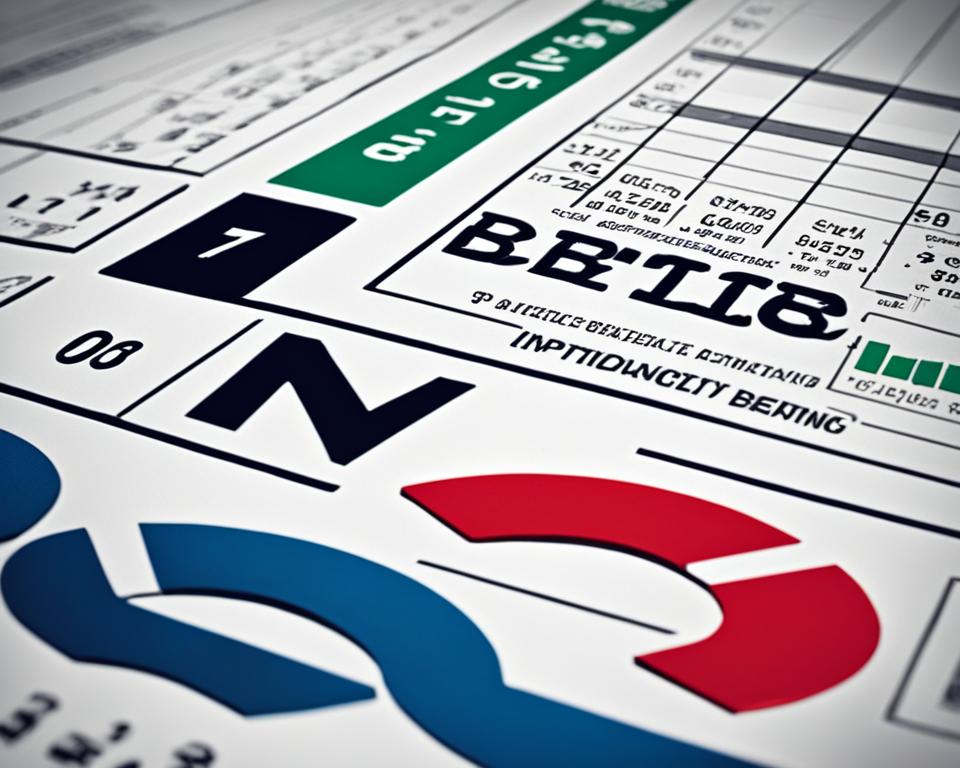Are you new to the world of sports betting? Do you find yourself confused by the numbers and symbols associated with betting odds? Don’t worry – you’re not alone. Many beginners struggle to understand sports betting odds, but with a little guidance, you’ll be able to make sense of them in no time.
Betting odds are a crucial tool when it comes to placing bets on sports events. They not only reveal the oddsmaker’s opinion on the likelihood of different outcomes but also indicate how much money you need to risk to win a specific amount. So, let’s dive in and uncover the secrets behind sports betting odds.
Key Takeaways:
- Understanding sports betting odds is essential for beginners.
- Betting odds reflect the oddsmaker’s opinion and show the amount of money required to win a specific amount.
- There are different formats of betting odds, including American odds, fractional odds, and decimal odds.
- Converting odds into implied probabilities is crucial for assessing potential value in a bet.
- Developing a solid understanding of odds and their calculations is key to making informed betting decisions.
Note: This is just a sample introduction. The actual article would have detailed information and explanations about sports betting odds and how to understand them. It would cover various types of odds, the calculations for potential winnings, implied probabilities, and tips for betting with odds.
What Are Betting Odds?
Betting odds are a fundamental part of sports betting. They represent an oddsmaker’s opinion on a particular game, event, or proposition and provide valuable information to bettors. Understanding betting odds is essential for anyone looking to engage in sports betting, as they play a crucial role in determining potential winnings and assessing the value of a bet.
At its core, betting odds show how much money bettors must risk to win a specific amount. They display the relationship between the amount wagered and the potential payout. Odds can be represented in various formats, including American odds, fractional odds, and decimal odds, each offering a unique way of presenting the information.
The concept of vigorish, also known as vig or juice, is closely tied to betting odds. Vigorish refers to the amount charged by the sportsbook for taking bets. This fee ensures that the bookmaker makes a profit regardless of the outcome of the bet. It is important to factor in the vigorish when calculating potential winnings and assessing the value of a bet.
“Betting odds are like the language of sports betting. They allow us to understand the potential risks and rewards involved in placing a bet. By comprehending odds, bettors can make informed decisions and navigate the world of sports betting with confidence.”
Types of Betting Odds
There are three common formats used to represent betting odds:
- American Odds: These odds are primarily used in the United States and are represented with a plus (+) or minus (-) sign. Positive odds indicate the potential profit on a $100 bet, while negative odds show the amount that needs to be wagered to win $100.
- Fractional Odds: Fractional odds are popular in the United Kingdom and are displayed as fractions, such as 3-1 or 7-4. The numerator represents the potential profit, while the denominator represents the amount that needs to be wagered.
- Decimal Odds: Decimal odds are commonly used in Europe and express the potential payout as a decimal number. The odds represent the amount that will be returned on a $1 bet, including the initial stake.
Each format provides a unique way of presenting the odds, allowing bettors to choose the representation they find the most intuitive and familiar.
Comparing the Formats
While all three formats serve the same purpose of indicating potential winnings, they differ in the way they present the information. Here’s a simple comparison:
| American Odds | Fractional Odds | Decimal Odds |
|---|---|---|
| -125 | 4/5 | 1.80 |
| +200 | 2/1 | 3.00 |
| -110 | 10/11 | 1.91 |
As shown in the table above, American odds can be positive or negative, indicating the favorite and underdog, respectively. Fractional odds are presented as ratios, with the numerator representing the profit and the denominator indicating the amount wagered. Decimal odds are simple to understand, with the number representing the total payout per unit stake.
Regardless of the format used, it’s crucial to understand how to interpret and calculate betting odds. It allows bettors to make informed decisions and identify favorable betting opportunities.
Understanding American Odds
American odds are a popular format used in sports betting, providing valuable information about the potential outcomes and payouts of a bet. To fully grasp the concept of American odds, it’s essential to understand how they are structured and what they represent.
These odds are based on $100 as a standard unit, which makes it easier to calculate potential winnings. They can be either positive or negative, and each sign signifies a different meaning in relation to the bet and the teams or players involved.
Positive American Odds
When you encounter positive odds, it means that the team or player is considered the underdog in the game or event. Positive odds indicate the potential profit you can make on a $100 bet. For example, if the odds are +200, it means that you could potentially win $200 on a $100 bet if the underdog team or player is victorious.
It’s important to note that positive odds don’t include the original bet amount. So, a bet of $100 on +200 odds would yield a total return of $300, including the $200 profit and the initial $100 bet.
Negative American Odds
Negative odds, on the other hand, signify the betting favorite in the game or event. They show the amount you need to bet in order to win $100. For instance, if the odds are -150, it means you would have to wager $150 to potentially win $100.
Similar to positive odds, negative odds don’t include the original bet amount. So, a bet of $150 on -150 odds would yield a total return of $250, including the $100 profit and the initial $150 bet.
Even Money Odds
Even money odds, also known as “EV,” are represented as -100, +100, or zero. They indicate that the potential payout is equal to the amount wagered. In other words, if you bet $100 on even money odds, you either win $100 or lose $100, depending on the outcome of the bet.
Here’s a table summarizing the key points about American odds:
| Symbol | Meaning | Calculation for $100 Bet |
|---|---|---|
| + (Positive) | Underdog | Potential Profit on $100 Bet |
| – (Negative) | Favorite | Amount Needed to Win $100 |
| -100, +100, or EV | Even Money | Potential Payout Equals Amount Wagered |
Understanding American odds is crucial for making informed betting decisions and assessing potential value in wagers. Whether you’re betting on the favorite or the underdog, being able to interpret these odds empowers you to make more strategic choices in your sports betting journey.
Deciphering Fractional Odds
When it comes to sports betting, understanding fractional odds is essential. Fractional odds are commonly used in the UK and Ireland and are displayed as fractions, such as 3-1 or 7-4. But what do these numbers actually mean?
In fractional odds, the numerator represents the profit, and the denominator represents the bet amount. Let’s take the example of 3-1. This means that for every unit you bet, you would stand to make a profit of three units if your bet is successful. The total return would be four units (the profit plus your original stake).
Now, let’s consider another example: 7-4. In this case, for every unit you bet, you would stand to make a profit of seven units if your bet wins. The total return would be eleven units (the profit plus your original stake).
It’s important to note that fractional odds can represent both favorite and underdog bets. When the denominator is larger than the numerator, it indicates a favorite bet, where the probability of winning is higher according to the bookmaker’s assessment. Conversely, when the numerator is larger than the denominator, it indicates an underdog bet.
Favorite Bets
Let’s consider a favorite bet with fractional odds of 2-1. In this scenario, for every unit you bet, you would stand to make a profit of two units if your bet wins. The total return would be three units (the profit plus your original stake).
Underdog Bets
Now let’s look at an underdog bet with fractional odds of 5-2. In this case, for every unit you bet, you would stand to make a profit of five units if your bet wins. The total return would be seven units (the profit plus your original stake).
Understanding fractional odds is key to making informed betting decisions. By deciphering these odds, you can assess the potential profit and return of different bets, whether they are favorite or underdog bets.
| Fractional Odds | Profit | Bet Amount | Total Return |
|---|---|---|---|
| 3-1 | 3 units | 1 unit | 4 units |
| 7-4 | 7 units | 4 units | 11 units |
| 2-1 | 2 units | 1 unit | 3 units |
| 5-2 | 5 units | 2 units | 7 units |
Unraveling Decimal Odds
When it comes to sports betting odds, decimal odds are a popular format used outside the US. They provide a simple and straightforward way to understand the potential winnings of a bet. In decimal odds, the odds are represented as a single number, indicating the amount that would be collected on a $1 bet if it wins. This format eliminates the need for complicated calculations and makes it easier for bettors to determine their potential payouts.
Unlike American odds or fractional odds, decimal odds do not require any additional calculations or conversions. The displayed number represents the total amount that would be collected, including the original stake, if the bet is successful. For example, if the decimal odds are 2.50, a $1 bet would result in a total payout of $2.50, including the $1 stake and $1.50 profit.
Decimal odds between 1 and 2 are considered favorite bets. This means that the implied probability of the event occurring is greater than 50%. On the other hand, decimal odds of 2 represent an even money bet, where the implied probability is 50%. In both cases, the potential winnings are clearly indicated by the decimal number.
Let’s take a look at a practical example to further illustrate decimal odds:
| Event | Decimal Odds |
|---|---|
| Manchester United vs. Chelsea | 1.80 |
| Real Madrid vs. Barcelona | 2.50 |
| New York Yankees vs. Boston Red Sox | 3.25 |
The table above shows the decimal odds for three different events. In the first event, Manchester United has decimal odds of 1.80, indicating that a $1 bet would result in a total payout of $1.80 if Manchester United wins. In the second event, Real Madrid has decimal odds of 2.50, meaning a $1 bet would result in a total payout of $2.50 if Real Madrid wins. Finally, in the third event, the New York Yankees have decimal odds of 3.25, indicating a potential payout of $3.25 for a $1 bet on the Yankees.
In summary, decimal odds provide a clear and convenient way to understand the potential winnings of a bet. They eliminate the need for complex calculations and make it easier for bettors to evaluate their betting options. By simply looking at the decimal number, bettors can quickly assess the potential payout they would receive if their bet is successful.
Calculating Potential Winnings
Knowing how to calculate potential winnings is crucial for sports bettors. By understanding the different calculations for American, decimal, and fractional odds, you can make informed decisions and assess the potential value of a bet.
American Odds
American odds are represented as either positive or negative numbers. To calculate potential winnings for American odds, multiply the wager by the odds and divide by 100. The result represents the total payout if the bet is successful, including the initial wager.
Example:
If you bet $100 on a team with +200 odds:
Potential winnings = $100 * (+200/100) = $200
Decimal Odds
Decimal odds are displayed as a single number and represent the total payout for every $1 wagered. To calculate potential winnings for decimal odds, multiply the wager by the odds.
Example:
If you bet $50 on a team with decimal odds of 2.50:
Potential winnings = $50 * 2.50 = $125
Fractional Odds
Fractional odds are represented as fractions and can be calculated by multiplying the bet amount by the numerator and dividing by the denominator.
Example:
If you bet $80 on a team with fractional odds of 5/2:
Potential winnings = $80 * (5/2) = $200
Remember to adjust your calculations based on your standard betting unit. It’s essential to understand how potential winnings are calculated to make informed decisions and maximize your profits in sports betting.
Understanding Implied Probability
Implied probability is a fundamental concept in sports betting, as it provides an estimate of the likelihood of an outcome based on the odds set by bookmakers. By understanding implied probability, bettors can assess potential value in a bet and make more informed decisions.
To calculate implied probability, we need to convert odds into a percentage. The calculation method differs depending on whether you’re dealing with underdogs or favorites. Let’s break it down:
Calculating Implied Probability for Underdogs
When dealing with underdogs, the calculation is as follows:
(100 / (Odds + 100)) * 100
For example, if the odds for an underdog are +200, the calculation would be:
(100 / (200 + 100)) * 100 = 33.33%
This means that the bookmakers estimate a 33.33% chance of the underdog winning based on the odds provided.
Calculating Implied Probability for Favorites
Calculating implied probability for favorites follows a different formula:
(Odds / (Odds + 100)) * 100
For example, if the odds for a favorite are -150, the calculation would be:
(150 / (150 + 100)) * 100 = 60%
This indicates that the bookmakers estimate a 60% chance of the favorite winning based on the odds provided.
Converting odds into implied probabilities allows bettors to compare them with their own projections or models. If you believe there is a higher chance of an outcome than what the implied probability suggests, it may indicate value in a particular bet.

Now that you understand implied probability, let’s explore the concept of the house edge in sports betting, which can significantly impact your overall betting strategy and profitability.
Exploring the House Edge
The house edge plays a significant role in sports betting, influencing the profitability of bets for both bettors and sportsbooks. By understanding and exploring the house edge, bettors can make more informed decisions when placing their wagers.
The house edge refers to the percentage advantage that the sportsbook holds over bettors. It represents the profit margin that the sportsbook aims to achieve. The higher the house edge, the more difficult it becomes for bettors to be consistently profitable in the long run.
To calculate the house edge, you need to analyze the implied probabilities for both sides of a bet. Implied probability is the expected chance of an outcome as determined by bookmakers. By summing the implied probabilities for all possible outcomes, you can determine the house edge.
A lower house edge indicates a more favorable bet for the bettor. It suggests that there is a higher probability of winning and potentially earning a profit. Conversely, a higher house edge means that the sportsbook has a greater advantage over the bettor, making it more challenging to generate consistent profits.
Understanding the house edge is crucial for bettors when assessing the value of their bets. By comparing the house edge across different betting options, bettors can identify bets with a higher probability of success and potentially increase their long-term profitability.
Exploring the house edge can also help bettors develop a more strategic approach to their betting. By targeting bets with a lower house edge, bettors can focus on finding value opportunities and favorable odds that maximize their chances of winning.
It’s important to note that the house edge will vary across different sports and types of bets. Some sports may have a higher level of unpredictability, resulting in a higher house edge. On the other hand, sports with more predictable outcomes may offer a lower house edge.
Bettors should also consider the impact of other factors such as odds adjustments, market conditions, and their own assessment of the game or event. These factors can influence the house edge and the overall profitability of a bet.
Ultimately, exploring the house edge allows bettors to make more informed decisions and improves their chances of long-term success in sports betting. By understanding the underlying dynamics of the house edge, bettors can navigate the betting landscape with greater confidence and ultimately enhance their overall betting experience.
Tips for Betting with Odds
To improve your betting strategy and increase your chances of success, it’s important to follow these tips when betting with odds:
- Develop a solid understanding of odds: Take the time to learn how different types of odds work. Familiarize yourself with American odds, fractional odds, and decimal odds. Understanding the fundamentals of odds will help you make better-informed betting decisions.
- Use a standard betting unit: Managing your bankroll effectively is crucial for long-term success in sports betting. Consider using a standard betting unit, such as a fixed percentage of your overall bankroll, to prevent impulsive and reckless betting decisions.
- Compare implied probabilities: Implied probability is the expected chance of an outcome as determined by bookmakers. Compare the implied probabilities of different odds to your own projections or models. If you believe the bookmakers have undervalued a particular outcome, you may find value in placing a bet.
- Keep track of your bets: Record your bets and analyze your results regularly. Tracking your bets allows you to identify patterns, assess the effectiveness of your strategy, and make any necessary adjustments. Keeping a betting journal can provide valuable insights into your overall performance.
“By comparing implied probabilities to your own projections, you can identify value bets and increase your chances of success.” – Sports Betting Expert
By following these tips, you’ll be able to navigate the world of sports betting odds more effectively and make more informed and strategic betting decisions.

| Tips for Betting with Odds |
|---|
| Develop a solid understanding of odds |
| Use a standard betting unit |
| Compare implied probabilities |
| Keep track of your bets |
Common Betting Terms
Familiarize yourself with common betting terms to navigate the world of sports betting with confidence. Understanding these key terms will help you make informed decisions and improve your overall betting strategy.
Vigorish
Vigorish, also known as “vig” or “juice,” is the amount charged by the sportsbook for taking bets. It is essentially a commission that sportsbooks collect to ensure their profitability. Vigorish is built into the odds and is an important factor to consider when evaluating potential bets.
Favorite
A favorite is the team or individual expected to win a given match or event. In betting, favorites are indicated by negative odds, such as -150. This means that a bettor would need to wager $150 to win $100.
Underdog
An underdog refers to the team or individual expected to lose a match or event. Underdogs are indicated by positive odds, such as +250. This means that a $100 bet on the underdog would result in a $250 profit if the underdog wins.
House Edge
The house edge refers to the advantage that the sportsbook has over bettors. It is a built-in margin that ensures the sportsbook makes a profit in the long run. Understanding the house edge is crucial for evaluating the value of bets and identifying potential opportunities.
Point Spreads
Point spreads are a popular form of betting that aims to level the playing field between two teams of different skill levels. The favored team is expected to win by a certain number of points, while the underdog is expected to lose by the same margin. Betting on the point spread involves placing bets on whether a team will cover or beat the given spread.
Moneyline Bets
Moneyline bets are straightforward bets on which team or individual will win a game or event. Instead of dealing with point spreads, moneyline bets focus solely on the outcome. Negative odds indicate the favorite, while positive odds represent the underdog.
Over/Under Bets
Over/under bets, also known as totals, involve predicting whether the combined score of two teams in a game will be over or under a certain number set by the sportsbook. Bettors wager on whether the total score will exceed or stay below the specified line.
Chalk
In sports betting, chalk refers to a heavily favored team. It is often used to describe a team that is expected to win by a significant margin. Betting on the chalk means placing bets on the favorite to win, usually resulting in lower odds and smaller payouts.
Understanding these common betting terms will give you a solid foundation when diving into the world of sports betting. With this knowledge, you’ll be better equipped to analyze odds, identify value, and make informed betting decisions.
Conclusion
Understanding sports betting odds is crucial for beginners looking to grasp betting lines. Betting odds represent an oddsmaker’s opinion and reflect the amount of money bettors must risk to win a specific amount. By understanding the different types of odds – including American odds, fractional odds, and decimal odds – as well as calculating potential winnings, bettors can make more informed decisions.
It is also important to consider implied probability and the house edge when assessing the value of bets. Implied probability is the expected chance of an outcome as determined by bookmakers, and converting odds into implied probabilities can help identify potential value bets. Additionally, understanding the house edge – the percentage advantage the sportsbook has over bettors – can help bettors make more favorable wagering choices.
To develop a solid betting strategy, it is recommended to compare implied probabilities to one’s own projections or models, track and analyze betting results, and manage bankroll effectively using a standard betting unit. By doing so, beginners can navigate the world of sports betting odds with confidence and improve their chances of success.
FAQ
What are betting odds?
Betting odds represent an oddsmaker’s opinion on a particular game, event, or proposition. They also indicate how much money bettors must risk to win a specific amount.
How do sports betting odds work?
Sports betting odds are expressed in different formats such as American odds, fractional odds, and decimal odds. These formats show how much you need to bet to win a certain amount or how much profit you can make from a bet.
What are American odds?
American odds are based on $100 and can be positive or negative. Negative odds indicate the betting favorite and show how much you need to bet to win $100. Positive odds represent the underdog and show how much profit you will get on a $100 bet.
How do I decipher fractional odds?
Fractional odds are displayed as fractions, such as 3-1 or 7-4. The numerator represents the profit, and the denominator represents the bet amount. Favorite bets have a denominator larger than the numerator, while underdog bets have the numerator bigger than the denominator.
What are decimal odds?
Decimal odds are shown as one number, representing the amount a winning bet would collect on a $1 bet. Odds between 1 and 2 are favorite bets, while odds of 2 are even money bets. Decimal odds are commonly used outside the US and provide a simpler way to calculate potential winnings.
How do I calculate potential winnings?
To calculate potential winnings, multiply the wager by the odds for American and decimal odds. For fractional odds, multiply the bet amount by the numerator and divide by the denominator. Adjust the calculations based on your standard betting unit.
What is implied probability?
Implied probability is the expected chance of an outcome as determined by bookmakers. It is essential to convert odds into implied probabilities to assess potential value in a bet.
How do I calculate implied probability?
The calculation differs for underdogs and favorites. For underdogs, use 100/(Odds + 100) * 100. For favorites, use Odds/(Odds + 100) * 100.
What is the house edge?
The house edge represents the percentage advantage the sportsbook has over bettors. By summing the implied probabilities for both sides of a bet, you can determine the house edge. A lower house edge indicates a more favorable bet.
What are some tips for betting with odds?
Develop a solid understanding of odds and how they work. Consider using a standard betting unit to manage your bankroll effectively. Compare implied probabilities to your own projections or models to identify value bets. Keep track of your bets and analyze your results to improve your betting strategy.
What are common betting terms?
Common betting terms include vigorish, favorite, underdog, and house edge. It is also important to understand the difference between point spreads, moneyline bets, and over/under bets. Familiarize yourself with terms like chalk, which refers to a heavily favored team.
Is there a conclusion?
Understanding sports betting odds is crucial for beginners looking to grasp betting lines. By understanding the different types of odds and calculating potential winnings, bettors can make more informed decisions. Consider implied probability and the house edge to assess the value of bets and develop a solid betting strategy.





